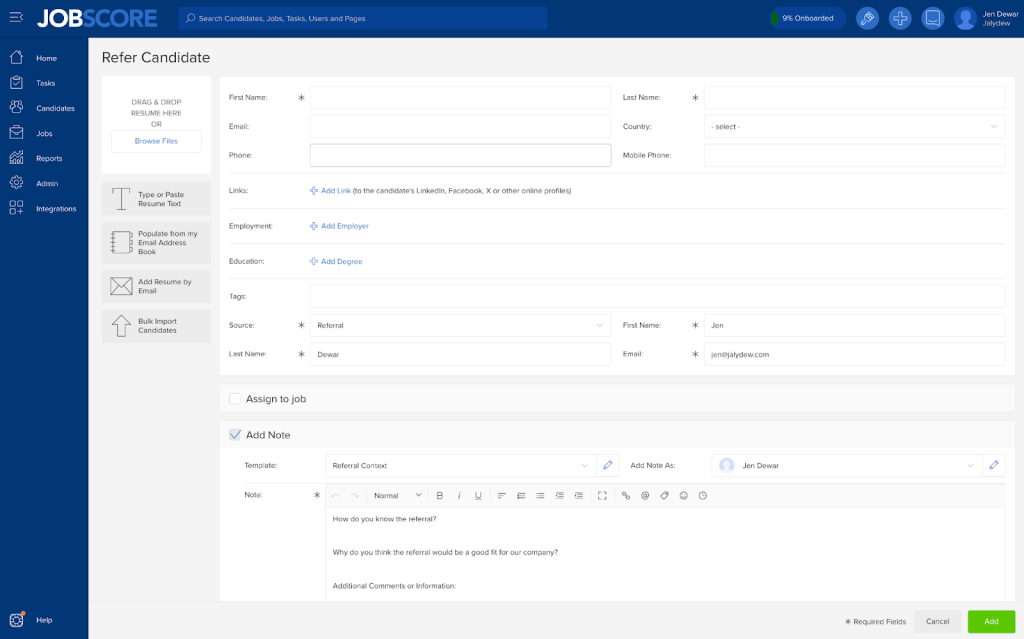
Subscribe for updates
Get talent acquisition best practices, trends, and news delivered directly to your inbox.
By entering your email, you agree to receive marketing emails from JobScore
Employee referrals consistently rank as the top source of hire. Referred candidates are often hired faster, stay longer, and perform better than those from other sources. Understanding how to increase employee referrals can be the difference between struggling to fill roles and building a pipeline of skilled, engaged candidates.
1
Communicate open positions regularly and clearly
Your team members can’t refer candidates for positions they don’t know exist. Establish a regular cadence of communication about open roles, perhaps once a week or twice a month, to highlight your current openings. Include brief descriptions of your ideal candidate and describe what success looks like in each role so your team members can match opportunities with their network connections.
2
Create referral materials your team members can share
Make it easy for employees to advocate for your company by providing ready-to-use content they can share with their networks. At a minimum, this means a well-written job description that includes the key responsibilities, required qualifications, and most compelling benefits or growth opportunities. Include employee testimonials, culture videos, or a quote from the hiring manager if you have them.
You might also provide pre-written social media posts or email templates that employees can use with minimal editing. Include relevant links and images to make sharing as seamless as possible. The easier you make it for employees to promote openings, the more likely they are to help.
3
Create a simple referral submission process
A complicated referral process is the fastest way to kill participation. Many employees will abandon the effort if submitting a referral requires lengthy forms, multiple steps, or confusing requirements. Aim for a submission process that takes less than a few minutes to complete.
Offer multiple ways your team members can share a candidate’s information, such as a name and email address, resume, LinkedIn profile, or portfolio. You might also ask your team member to answer a few short questions about their referral.

4
Highlight your program during onboarding
New employees represent a fresh network of potential candidates, often with connections from previous employers who might fit well at your company. Integrate your referral program into the onboarding process to capture this potential immediately.
Schedule some time with each new hire to:
Organizations with larger teams may do this in a group setting or only with top performers who might know more skilled talent.
5
Host regular “sourcing jams”
Sourcing jams are dedicated sessions where your team members can actively search their networks for potential candidates. Start with a brief overview of current openings and ideal candidate profiles. Then give employees time to browse their LinkedIn connections, email contacts, or professional association directories while recruiters or hiring managers circulate to answer questions. You can make them more convenient and enjoyable by providing lunch, coffee, or snacks.
These events can transform referrals from an afterthought into an engaging team activity. They create focused time for referrals and normalize the process, making it a standard part of your team’s work. Schedule these sessions quarterly or when you have several critical positions to fill.
6
Proactively source your team members’ networks
Don’t wait for team members to search their networks — be proactive about identifying potential matches. Connect with your team members on LinkedIn so you can view their connections. When you spot potential candidates, ask the team member if they’d recommend that person.
This approach flips the traditional referral model by removing the burden of searching and evaluating connections against your criteria. Your team members simply need to answer a few questions about the potential candidate and, if appropriate, make an introduction. The key is reducing the effort required from employees while still leveraging their knowledge of their connections’ qualifications and work styles.
7
Use a clear and compelling incentive structure
A compelling incentive structure can motivate team member participation. While cash bonuses are common, they’re not the only option. Survey your employees to discover what rewards would truly motivate them, whether it’s additional paid time off, gift cards, or experiences.
Consider a tiered approach for monetary rewards, based on position difficulty or seniority. This approach allows you to allocate your referral budget strategically, investing more in positions where employee networks are likely to provide the greatest value. It also signals to employees which roles are priorities for the company and creates additional motivation for referring candidates to more challenging positions.
You can also break your incentives up to offer particle payments at set milestones. For example, you could award a small gift card when a referred candidate completes an onsite interview, or split the incentive to offer half when the candidate is hired and the other half after 3 months.
8
Recognize and celebrate successful referrals
Recognition can be just as motivating as financial rewards. A simple “thank you” can go a long way toward helping your team members feel appreciated for their efforts and encouraging them to make future referrals. You might also announce new hires who come through referrals in company meetings or internal messaging channels, highlighting the employee who made the connection.
9
Follow up on referred candidates
Nothing kills referral momentum faster than employees feeling their recommendations disappear into a black hole. Create a transparent feedback loop that keeps referring employees informed throughout the process. This might include acknowledgment when a referral is received, updates as the candidate progresses through the hiring stages, and explanations when candidates are rejected.
Following up on referred candidates accomplishes two crucial goals: It shows employees their referrals are taken seriously, and it helps them make better referrals in the future. Employees who understand why certain referrals succeed and others don’t will naturally become more selective and accurate in their recommendations.
10
Make referrals part of your company culture
The most successful referral programs are embedded into company culture rather than existing as isolated HR initiatives. Talk about referrals regularly in company meetings, celebrate successful hires, and make it clear that building the team is everyone’s responsibility.
Leaders should model the behavior by prioritizing hiring initiatives, including making their own referrals. This signals the strategic importance of hiring on the entire organization.
11
Create referral competitions and campaigns
Short campaigns can reinvigorate your referral program and create a sense of urgency. Launch competitions with special rewards for referrals made during a specific period. This might coincide with a major hiring push or strategic initiative requiring additional talent.
Structure competitions to maintain quality while encouraging participation. For example, consider categories like “most referrals that reached the interview stage” or “most diverse slate of candidates.”
12
Leverage your applicant tracking system
Most modern applicant tracking systems offer features to support employee referral programs. Take full advantage of these capabilities to streamline administration and improve the experience for both employees and candidates. Configure your ATS to automatically track referral sources, streamline communication, and enable team members to stay in the loop.
13
Treat candidates well
Only 26% of North American job seekers say they had a great candidate experience. And 13% had such a terrible experience that they’re less likely to apply again, refer others, have any brand affinity, and make purchases from the company. Your team members won’t continue to refer their personal connections if you don’t treat them well.
Make it a point to stay in regular communication with referred candidates and treat them with respect throughout the recruitment process.
14
Gather and implement employee feedback
Your employees are the primary users of your referral program, and their experience directly impacts its success. Regularly gather feedback to understand what’s working, what’s challenging, and what could be improved. This might include anonymous surveys, focus groups with active referrers, or suggestion boxes.
Ask specific questions about the submission process, incentive structure, communication, and overall experience. Pay particular attention to employees who have referred candidates, as they can provide insights on both the employee and candidate experience. Also seek input from employees who haven’t participated to understand what barriers might be preventing their involvement.
Most importantly, act on the feedback you receive. Implement suggested improvements, address common pain points, and communicate changes back to employees. This responsive approach demonstrates that you value their input and are committed to creating a program that works for everyone.
Final thoughts on how to increase employee referrals
A thriving employee referral program can be a tremendous resource to help you build a high-quality candidate pipeline — but building one can take time. Start by selecting the strategies that address your most pressing challenges, whether that’s a lack of motivating incentives, a poor candidate experience, or a complicated submission process. Make improvements, gather feedback, and measure results to continually refine your approach. Over time, you should begin to see more high-quality employee referrals from your team.



